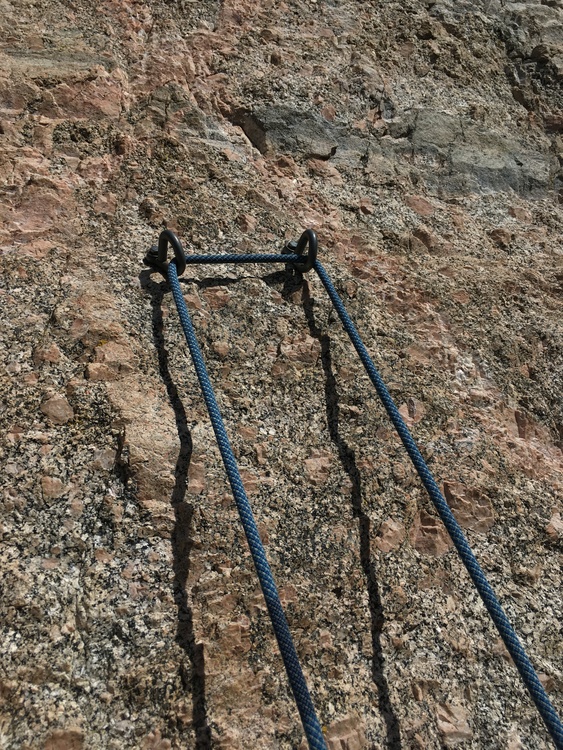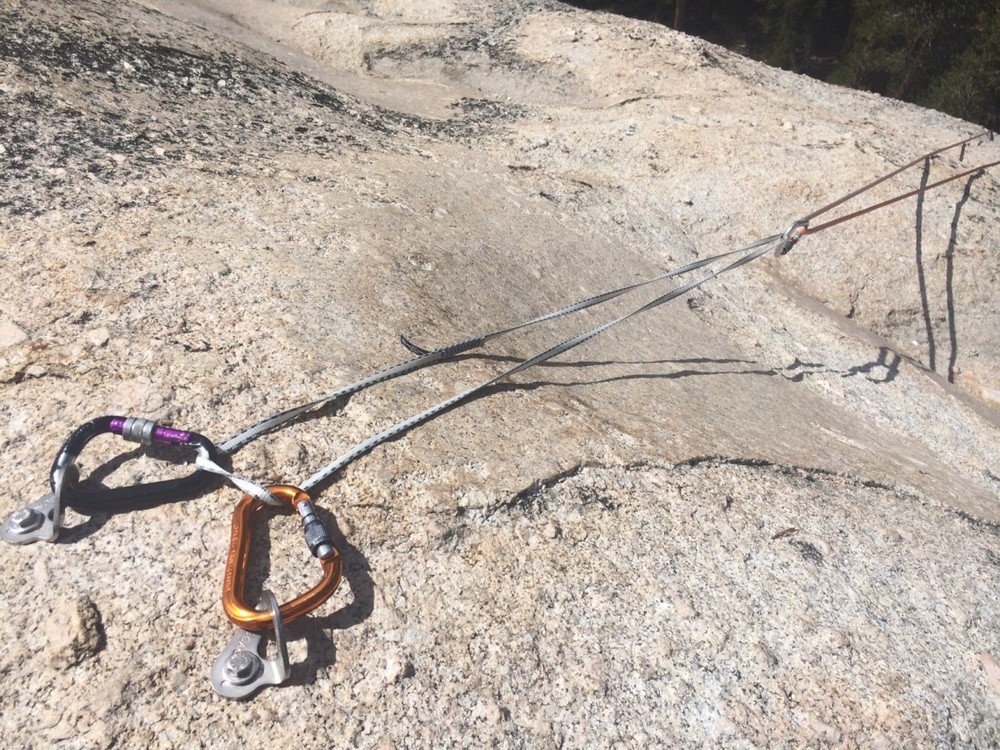|
|
Old Prospector
·
May 3, 2019
·
UT
· Joined Feb 2017
· Points: 147
So I've been climbing most of my life, only in the past year though have I gotten my own gear and started taking myself out, still getting used to rappelling off the top of routes, building anchors, etc.
Snapped this photo as I rappelled today, in some way isn't the forces exerted on the two bolts similar to the forces exerted by an American Death Triangle style anchor? Maybe Im guessing the forces wrong, but the two setups seem pretty similar. Why then is rappelling like this okay, but a triangle anchor a big no no? Any explanation on the physics of it would be great. Just trying to better understand the reasons behind whats safe and whats not.
My rappel setup today ^ American death triangle image from google ^
|
|
|
Kevin Szczepaniak
·
May 3, 2019
·
Unknown Hometown
· Joined Mar 2019
· Points: 0
The forces generated by rappelling are much lower than those that can be created on a top rope anchor from belaying. You are correct with pointing out the ADT-esque shape of the rappel set up, but the forces are small enough to not matter
|
|
|
William R
·
May 3, 2019
·
Unknown Hometown
· Joined Apr 2019
· Points: 8
Both photos are death triangles. They pull on each anchor in two directions which multiply's the force put on each anchor. On your top photo you could easily place two quick draws(one on each anchor) bringing the connection point down and together and then attach your rope if you don't want to tie anything(as long as the bottom carabiners are at equal height). For a rap its not as big of an issue as if your climbing and fall.
|
|
|
Jay Eggleston
·
May 3, 2019
·
Denver
· Joined Feb 2003
· Points: 21,381
The biggest issue with the top photo is the cold shuts. Not good anchor hangers and they are not welded shut either.
|
|
|
Zachary Winters
 ·
May 3, 2019
·
Winthrop, WA
· Joined Aug 2014
· Points: 430
·
May 3, 2019
·
Winthrop, WA
· Joined Aug 2014
· Points: 430
Believe it or not, this set up won't put crazy high forces on the anchor. The resultant forces create imaginary lines that will meet and form a ~90° angle which means each anchor will take about 70-75% of your weight, or about 0.7kn for smooth rappelling. With a death triangle with a higher focal point, say equalateral, the resultant forces will meet at an obtuse angle which is where you get into more serrious force multiplying.
But that'll twist the hell out of your rope. Good thinking critically about the anchors you see outdoors.
|
|
|
Alexander Stathis
·
May 4, 2019
·
Chattanooga, TN
· Joined Jan 2016
· Points: 656
Z Winters wrote: Believe it or not, this set up won't put crazy high forces on the anchor. The resultant forces create imaginary lines that will meet and form a ~90° angle which means each anchor will take about 70-75% of your weight, or about 0.7kn for smooth rappelling. With a death triangle with a higher focal point, say equalateral, the resultant forces will meet at an obtuse angle which is where you get into more serrious force multiplying.
But that'll twist the hell out of your rope. Good thinking critically about the anchors you see outdoors. The force on each anchor depends on the length of the sides of the triangle, right? At the beginning of the rappel when the sides of the triangle are smallest the force will be the highest. Even then though, the angle should be low enough that the forces, while still amplified, shouldn't be absurdly large. When the triangle is equilateral (which is probably how it's initially loaded in a rappel), each anchor should be holding roughly 133% the weight of the climber on rappel. As you descend, the force on each anchor decreases.
|
|
|
Zachary Winters
 ·
May 4, 2019
·
Winthrop, WA
· Joined Aug 2014
· Points: 430
·
May 4, 2019
·
Winthrop, WA
· Joined Aug 2014
· Points: 430
Alexander Stathis wrote: The force on each anchor depends on the length of the sides of the triangle, right? At the beginning of the rappel when the sides of the triangle are smallest the force will be the highest. Even then though, the angle should be low enough that the forces, while still amplified, shouldn't be absurdly large. When the triangle is equilateral (which is probably how it's initially loaded in a rappel), each anchor should be holding roughly 133% the weight of the climber on rappel. As you descend, the force on each anchor decreases. Yes! I almost mentioned this, but decided my comment was wordy enough :) But yes, essentially the apex of the triangle in this case is the rappel device. If loaded with the bolts at your chest, the forces could get high, but if loaded with the bolts overhead it wouldn't be as bad. As you decent the forces will theoretically decrease, but once you're a few meters down the change will be minimal. OP, keep up the anchor scepticism - that's exactly the kinda stuff you want to watch it for.
|
|
|
Malcolm Daly
·
May 4, 2019
·
Hailey, ID
· Joined Jan 2001
· Points: 380
The problem with the ADT isn’t the forces generated. They’re pretty similar regardless of whether you’re clipped into draws, a master knotted sling or a sliding x. The problem with an ADT (and the sliding x) is that if the sling breaks you’re gone. There’s no redundancy with either. This killed some kids in the Red a few years ago.
|
|
|
Zachary Winters
 ·
May 4, 2019
·
Winthrop, WA
· Joined Aug 2014
· Points: 430
·
May 4, 2019
·
Winthrop, WA
· Joined Aug 2014
· Points: 430
For sure. Unless of course there are multiple pieces of tat in the triangle configuration. But that's just silly, when it doesn't use much more material to do it right.
|
|
|
Bill Lawry
·
May 4, 2019
·
Albuquerque, NM
· Joined Apr 2006
· Points: 1,812
Z Winters wrote:
But that'll twist the hell out of your rope. . The second rig with the lockers? I was involved with a party once who top roped that way. I have never seen such worse twisting. Built up about 15 feet of a rats nest at the tie in of the newbie top roper.
|
|
|
mediocre
·
May 4, 2019
·
Unknown Hometown
· Joined Jul 2013
· Points: 0
Malcolm Daly wrote: The problem with the ADT isn’t the forces generated. They’re pretty similar regardless of whether you’re clipped into draws, a master knotted sling or a sliding x. The problem with an ADT (and the sliding x) is that if the sling breaks you’re gone. There’s no redundancy with either. This killed some kids in the Red a few years ago. This. If there are multiple pieces of tat then it is not an ADT
|
|
|
Zachary Winters
 ·
May 4, 2019
·
Winthrop, WA
· Joined Aug 2014
· Points: 430
·
May 4, 2019
·
Winthrop, WA
· Joined Aug 2014
· Points: 430
Bill Lawry wrote: The second rig with the lockers? I was involved with a party once who top roped that way. I have never seen such worse twisting. Built up about 15 feet of a rats nest at the tie in of the newbie top roper. Why would the second setup (lockers) twist the rope? It's just a rope running through a single locker. Shitty anchor to be sure, but won't twist the rope unless the rope ran where the sling is.
|
|
|
Jim Titt
·
May 4, 2019
·
Germany
· Joined Nov 2009
· Points: 490
Z Winters wrote: Why would the second setup (lockers) twist the rope? It's just a rope running through a single locker. Shitty anchor to be sure, but won't twist the rope unless the rope ran where the sling is. This.
|
|
|
Robert Hall
 ·
May 4, 2019
·
North Conway, NH
· Joined Aug 2013
· Points: 27,827
·
May 4, 2019
·
North Conway, NH
· Joined Aug 2013
· Points: 27,827
In the 2nd (lower) photo the climbing rope runs through a single-point: one 'biner (or 2, you can't see which). A rope running through a single point should NOT tangle the rope; but, of course, had the climbing rope been placed directly through the upper two biners, then "mega tangles" would be produced. (The same if you lowered-on-belay off the 2 cold shuts seen in the top picture.) [Note- this comment was being typed as the immediately-above comment was being posted.]
The basic principle is: avoid a single point of failure being catastrophic. In the bottom photo the single sling, if cut (say by a falling rock, or over an edge, or just because it's a bad sling) would result in failure of the entire system. In the top photo, a (highly unlikely) failure of either cold-shut results in the force (your body weight) transferring to the other. Not ideal, but you'd probably live.
The classic "ADT" is where a sling is tied through two (usually horizontal) points and the sling is set without a knot (usually fig-8) on the bottom such that if either leg of the sling breaks, or either point of anchor fails, the whole thing "unravels". The more obtuse the angle that the slings make with the anchor points, the worse it is. (If a theoretical 180 degrees, i.e. horizontal, is maintained, then any force applied to the mid-point results the force on each anchor is, in theory, infinity.)
|
|
|
Alexander Stathis
·
May 4, 2019
·
Chattanooga, TN
· Joined Jan 2016
· Points: 656
Malcolm Daly wrote: The problem with the ADT isn’t the forces generated. They’re pretty similar regardless of whether you’re clipped into draws, a master knotted sling or a sliding x. The problem with an ADT (and the sliding x) is that if the sling breaks you’re gone. There’s no redundancy with either. This killed some kids in the Red a few years ago. Yeah, but even if you double up the sling you're still using more gear and putting more force on the anchors than if you just used a single sling and a properly tied anchor. So yes, the major issue is the redundancy, but you're also unnecessarily putting roughly 50-100% more force on each anchor point in that configuration (than in the standard single sling with a masterpoint configuration).
|
|
|
Bill Lawry
·
May 4, 2019
·
Albuquerque, NM
· Joined Apr 2006
· Points: 1,812
Z Winters wrote: Why would the second setup (lockers) twist the rope? It's just a rope running through a single locker. Shitty anchor to be sure, but won't twist the rope unless the rope ran where the sling is. It isn’t that the anchor is inadequate for the load. The severe twisting happens when the biners are constrained from freely orienting to the pull of the rope. And a tight top rope helps amplify the twist. That was the case in the experience I mentioned. Yeah. Kind of off topic.
|

 Continue with onX Maps
Continue with onX Maps Continue with Facebook
Continue with Facebook






















